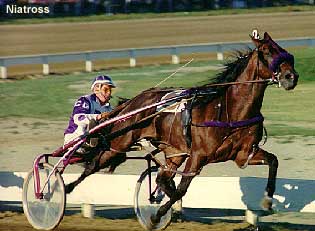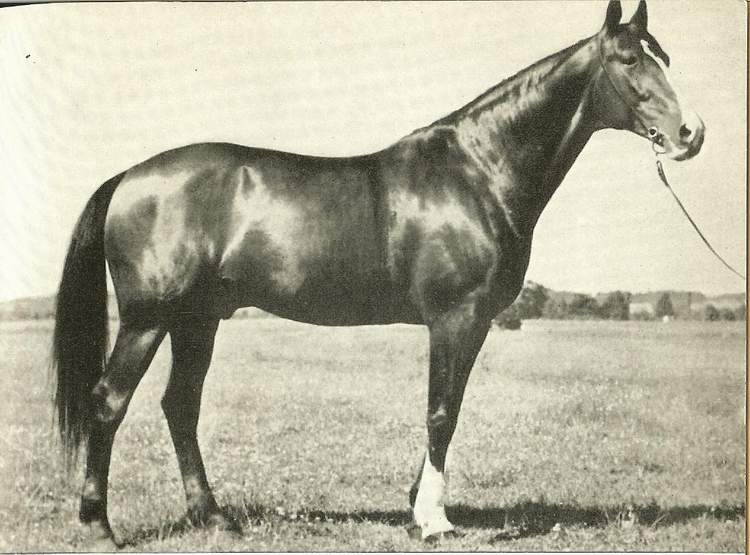

Standardbred


Introduction: If you have any comments or suggestions, please click here. As you can see by the label, the picture on the left is of the famous Standardbred Niatross; the one on the right, which I chose because it shows the conformation somewhat better, is of a Standardbred named Man of Action.
Names: Standardbred,
American Standardbred. The term "standardbred" originally meant
a horse of any breed that could trot the mile in harness within a certain
standard time. The standard has lowered over the years and is now 2:20 (2
minutes and 20 seconds) for two-year-olds and 2:15 for older horses. If a
horse meets this standard, he qualifies to run in officially recognized
meets. "Standardbred" became the name for the pedigreed family
of horses bred for racing in harness.
The name Standardbred may also be hyphenated (as in
Standard-bred Horse), and this breed has also been called simply the American
Trotter (as compared to the French Trotter, Russian Trotter, etc).
Origin: The
American custom of racing horses in harness goes back to colonial days--to the
neighborly "brush" two men might have while driving their trotters to
town, or to the races that sparked holiday celebrations and fairs. Just as
harness racing today is vastly different from its origins, so are the horses
themselves. The roadsters of early days were mostly utility horses that
were also fast runners. But when trotting grew into a major sport, early
in the 1800's, a more specialized type of animal was needed. In seeking to
create such a horse, breeders looked to the progeny of an imported Thoroughbred
stallion called Messenger, a
descendant of the Darley Arabian. As Messenger's descendants multiplied it
was noted that they possessed speed and were naturally inclined to the trotting
gait. And indeed it was one of Messenger's grandsons, Rysdyck's
Hambletonian, that in time earned recognition as foundation sire of the
Standardbred family, the breed which has been developed over the past century
especially for racing in the trot or pace.
From an old source: Originated in America at the
beginning of the last century from English Thoroughbreds and Norfolk and
Anglo-Norman Trotters (as a harness horse breed--Standard-bred Horse--which
included both pacers and trotters). This original breed, which consisted
almost solely of very much larger and stronger strains originating in France
(also from Anglo-Norman Trotters and Thoroughbreds), has today become almost
completely integrated in the Standard-bred. Selection for breeding
nowadays is made only on the basis of the severest races, on the same lines as
the Thoroughbred. Used by Soviets after the Russian Revolution for
regenerating the Orlov breed.
Breeding: Originally
of mixed heritage, including Thoroughbred,
Dutch Harddraver (I believe that is the Friesian)
and Norfolk Roadster, these horses were bred until 1871 without a fixed
standard, which was then established on racing performance. Of today's trotters and pacers, perhaps nine out of ten trace
back to Rysdyck's Hambletonian. Thoroughbred
blood is predominant in
the breed, though Morgan
and other strains have been introduced to provide
ruggedness.
An old source stated the following, which I find a bit
surprising and confusing: Breeding area and studs widespread throughout
the world. Numerous studs in U.S.A. and Europe. Large-scale
breeding, in terms of both numbers and efficiency, in U.S.A. and France.
All existing horses accepted by the Standard-bred Register are considered as
Standard-bred Horses.
Description: The modern Standardbred is said to look much like a more robust but smaller type of Thoroughbred.
Action: Often very short step; rapid, racing trot, covers the ground and the propelling rear legs pass in front of the forelegs while still in supporting position on the ground. Uneven gallop.
Body: Angular shape. Croup short and cut away, usually raised and often higher than the withers (the so-called "trotting pitch"). Neck low set and narrow; rather steep, short shoulders; back and loins often weak. Barrel long and overall quite slender and flat.
Color: Any solid color; usually bay, black, or brown.
Head: Sometimes relatively large and ungainly, with long ears and large, intelligent eyes.
Hooves: Angle of rear foot almost rectilinear.
Legs: Especially well muscled. Rear legs placed well under body. Notably long pasterns. Short cannons; hocks set low; splay-footed stance; often has tendency to spavin; sometimes long-legged without sufficient depth.
Size: 15-16 hands. An old source stated 15.1 to 16.3 hands.
Temperament: Amiable disposition, lively and keen.
Features: He inherits a tendency for either the trotting or pacing gait. His trainer's job is to develop this talent. The excellent harness horse features also enable it to be used for agricultural purposes, though this seems to have been an older use that has mainly died out. It also often has considerable jumping talent.
Uses: Races in carts called sulkies.
Accomplishments:
Curiosities: Puritanical early settlers got around their objections to the sinful pastime of ridden racing and indulged their sporting instincts by impromptu matches between driven "roadsters," a recreation that developed into the immensely popular and highly organized trotting races of today.
Profiles: Hambletonian 10 - foundation sire of the Standardbred breed, see Standardbred Profiles.
Conclusion: